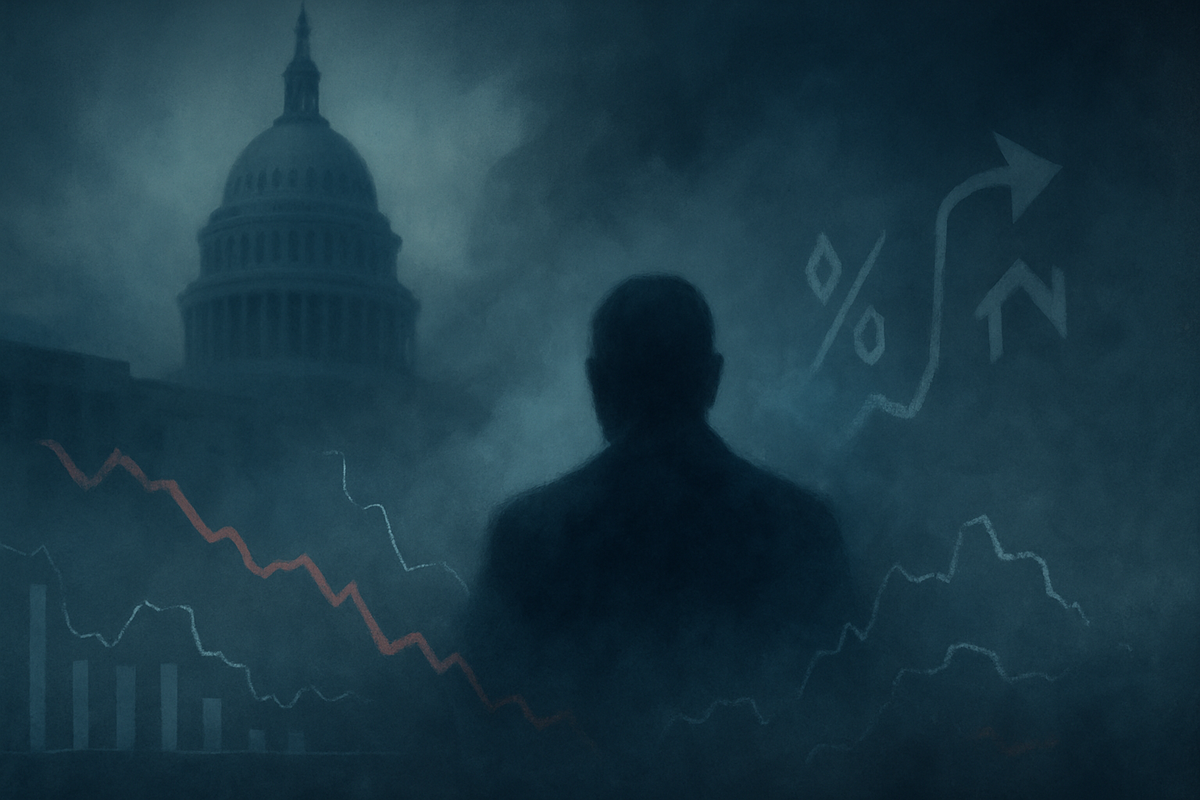
The U.S. economy finds itself at a critical juncture, navigating persistent inflation and a cooling labor market, while simultaneously grappling with the immediate and profound implications of an ongoing government shutdown. As of October 3, 2025, the federal government remains unfunded, triggering a widespread data blackout that has delayed the release of crucial jobs data. This unprecedented information vacuum leaves the Federal Reserve (the Fed) in an extraordinarily difficult position, effectively "flying blind" as it attempts to assess the nation's economic health and make informed decisions about interest rates and mortgage rates. The delay of the highly anticipated September Employment Situation Report, typically a cornerstone of the Fed's monetary policy deliberations, casts a long shadow of uncertainty over financial markets and business planning nationwide.
The Shutdown's Grip: Halting the Flow of Vital Economic Intelligence
The current government shutdown, which commenced on October 1, 2025, has immediately brought to a halt the "non-essential" operations of numerous federal agencies, including those responsible for collecting and disseminating the nation's most vital economic statistics. Foremost among these is the Bureau of Labor Statistics (BLS), an agency within the Department of Labor, which has suspended all operations. This means the September Employment Situation Report, a comprehensive monthly overview of non-farm payrolls, the unemployment rate, and average hourly earnings, which was slated for release on October 3, 2025, has been indefinitely postponed.
The timeline of events leading to this moment began on September 30, 2025, when Congress failed to pass appropriation bills or a continuing resolution to fund federal operations. By 12:01 AM ET on October 1, the government officially shut down, leading to the furlough of hundreds of thousands of federal employees. As the BLS ceased its functions, the data blackout became a reality, directly impacting the Federal Reserve's ability to gauge the economy. Other critical data, such as the Consumer Price Index (CPI) and third-quarter GDP figures, are also at risk of delay if the shutdown persists.
Key stakeholders in this unfolding drama include the Bureau of Labor Statistics (BLS), the Department of Labor (DOL), the Bureau of Economic Analysis (BEA), and the U.S. Census Bureau, all of which are directly impacted by the funding lapse. The Federal Reserve, as the central bank, is a primary user of this data, and its ability to conduct monetary policy is now severely hampered. On the political front, Congress and the President are the key players whose inability to reach a funding agreement directly caused the shutdown, with the Office of Management and Budget (OMB) overseeing the operational aspects.
Initial market reactions to the data delays have been mixed. While some indices, like the S&P 500 (NYSEARCA: SPY), have shown surprising resilience, economists and policymakers are widely reported to be "flying blind." The absence of official data has forced a greater reliance on less comprehensive private-sector indicators, such as the ADP National Employment Report, which recently indicated a decline in private-sector jobs. This patchwork approach to economic assessment increases uncertainty and the risk of policy missteps, especially with the Fed's late-October meeting looming.
Corporate Crossroads: Winners and Losers in the Data Vacuum
The ongoing data blackout due to the government shutdown introduces a thick fog of economic uncertainty, creating distinct challenges and opportunities for public companies across various sectors. Companies highly sensitive to consumer confidence, interest rate expectations, and predictable economic indicators are likely to bear the brunt of the disruption.
Sectors and Companies Likely to Lose:
- Consumer Discretionary: Companies in this sector, offering non-essential goods and services, are highly vulnerable. Reduced consumer confidence and potential furloughs for federal employees directly translate to decreased spending. Automakers like Ford (NYSE: F) and General Motors (NYSE: GM) may see deferred large purchases. Retailers such as Macy's (NYSE: M) and specialty retailers will likely experience a dip in sales, while the travel and hospitality industries, including Marriott International (NASDAQ: MAR) and Delta Air Lines (NYSE: DAL), could face reduced leisure and business travel.
- Housing and Real Estate: This sector is acutely sensitive to consumer sentiment and interest rates. Homebuilders like Lennar Corporation (NYSE: LEN) and PulteGroup (NYSE: PHM) may see slower sales and investment due to uncertainty. Mortgage lenders like Rocket Companies (NYSE: RKT) could face processing delays for government-backed loans (FHA, VA, USDA), impacting transaction volumes.
- Financial Services: While some large banks like JPMorgan Chase (NYSE: JPM) and Wells Fargo (NYSE: WFC) might ordinarily benefit from certain interest rate movements, the uncertainty caused by missing data is detrimental. Reduced lending activity, increased credit risk, and market volatility complicate investment strategies. Delays in regulatory approvals from agencies like the SEC (Securities and Exchange Commission) can also hinder IPOs and M&A activities.
- Manufacturing and Industrials: These capital-intensive sectors, represented by companies like Boeing (NYSE: BA) and Caterpillar (NYSE: CAT), rely on stable demand and clear economic signals for planning and investment. Reduced consumer spending and tighter credit conditions can lead to decreased orders and stalled expansion plans.
Sectors and Companies Likely to Win (or be less negatively affected):
- Consumer Staples: Companies providing essential goods such as food, beverages, and household items tend to be resilient during economic downturns. Procter & Gamble (NYSE: PG), Coca-Cola (NYSE: KO), and Walmart (NYSE: WMT) are examples of firms with inelastic demand, offering stable revenue streams.
- Healthcare: Demand for healthcare services remains relatively stable irrespective of economic conditions. Pharmaceutical giants like Johnson & Johnson (NYSE: JNJ) and Pfizer (NYSE: PFE), and health insurers such as UnitedHealth Group (NYSE: UNH), are generally less cyclical.
- Utilities: Companies like NextEra Energy (NYSE: NEE) and Duke Energy (NYSE: DUK) provide essential services like electricity and natural gas, ensuring consistent demand and making them defensive investments.
- Certain Technology Companies: Large, diversified tech companies with strong enterprise or subscription-based services, such as Microsoft (NASDAQ: MSFT), may be less impacted as their services are often critical for business operations.
- Companies with Strong Balance Sheets: Businesses with robust financial health, ample cash reserves, and low reliance on external borrowing are better equipped to absorb economic shocks and potentially capitalize on opportunities that arise during instability.
Broader Ripples: Beyond the Data Delay
The delay in jobs data and other critical economic indicators due to the government shutdown extends far beyond mere statistical inconvenience; it has profound wider significance for the U.S. economy, its global standing, and the very framework of monetary policy. This "data blind spot" exacerbates existing vulnerabilities in an economy already facing "unusual uncertainty."
The current economic backdrop, prior to the shutdown, was characterized by conflicting signals: inflation stubbornly above the Federal Reserve's 2% target, while job creation had notably slowed, and the unemployment rate had begun to trend higher in August. The absence of fresh data makes it exceedingly difficult to ascertain the true momentum of these trends, whether the economy is heading towards a deeper slowdown or a potential recession. Each week of a government shutdown is estimated to reduce annualized quarterly GDP growth by approximately 0.2 percentage points, with only partial recoupment after reopening.
The ripple effects are far-reaching. Businesses, deprived of reliable federal data on labor market health and consumer spending, struggle to accurately forecast demand, make investment decisions, and manage hiring strategies. This fosters a risk-averse environment, dampening entrepreneurial activity. Financial institutions face challenges in credit scoring and regulatory compliance, while the housing market may see a decline in mortgage applications. Companies reliant on federal contracts or permits, such as defense contractors and their subcontractors, experience stalled timelines and payment delays. Internationally, a prolonged shutdown can project an image of instability for the U.S., potentially impacting the strength of the U.S. dollar and investor confidence in U.S. markets.
For the Federal Reserve, the regulatory and policy implications are severe. The Fed's data-dependent framework for setting monetary policy, particularly interest rates, is fundamentally disrupted. Without accurate jobs, inflation, and GDP figures, the Fed is "flying blind" ahead of its late-October policy meeting. This increases the risk of policy missteps, such as adjusting rates without a complete picture of economic pressures. The Fed and other forecasters are forced to rely on less comprehensive private-sector data, which may not capture the full scope of the economy, including the impact on government agencies. A sustained lack of reliable data could hamper the Fed's ability to implement effective monetary policy, potentially prolonging periods of economic uncertainty.
Historically, government shutdowns have resulted in similar data delays. The 2013 government shutdown delayed the September jobs report by about two weeks, although the quality of the data released later was largely unaffected. The 2018-2019 shutdown, the longest in U.S. history, saw the BLS largely continue data releases due to prior funding. However, the current shutdown is different; the BLS has entirely suspended operations. This, coupled with an already weakening labor market and persistent inflation, makes the current shutdown more precarious than previous ones, increasing the potential for more severe consequences and prolonged market uncertainty.
The Path Ahead: Navigating the Fog of Uncertainty
As the government shutdown persists into October 2025, the path ahead for the Federal Reserve, businesses, and investors is shrouded in a fog of unprecedented uncertainty. The prolonged delay in critical jobs data necessitates strategic pivots and adaptations across the economic landscape.
In the short term, the Federal Reserve faces an "extraordinarily difficult spot" ahead of its October 28-29 Federal Open Market Committee (FOMC) meeting. Without the September jobs report and potentially other key data like CPI, the Fed's usual data-dependent approach is compromised. They will likely increase reliance on alternative, private-sector data, such as ADP employment figures and regional Fed surveys, though these are less comprehensive. The Fed might consider a "risk management" rate cut, preemptively easing policy to cushion against potential economic deterioration, or, conversely, adopt a "hawkish wait-and-see" stance, preferring to hold rates steady until clearer data emerges. Mortgage rates are also expected to exhibit increased volatility, with government-backed loan processing potentially facing delays.
Looking further out, a prolonged shutdown carries more significant risks. A sustained lack of reliable economic data can erode public and investor confidence, potentially dampening economic growth beyond the estimated 0.1-0.2 percentage points of GDP loss per week. The threat of permanent federal layoffs, unlike temporary furloughs, could inflict lasting damage on the labor market and consumer spending. Such an event could force the Fed to fundamentally re-evaluate its reliance on traditional government statistics, leading to a permanent shift towards integrating a broader array of private-sector data and developing new models for decision-making under uncertainty.
For businesses, the primary challenge is heightened market volatility and difficulty in strategic planning, particularly for sectors reliant on economic indicators. Companies with federal contracts face immediate disruptions, including delayed payments. However, opportunities may emerge for data-savvy companies with strong internal analytics to navigate the "data vacuum." Tactical investment opportunities could arise in duration plays (e.g., long-term Treasury bonds) and credit spread compression, as the Fed's actions may precede the full manifestation of economic stress. Historically, equities have shown resilience to shutdowns, with investors often looking past temporary disruptions.
Potential scenarios range from a short-lived shutdown, where the impact is largely temporary and the Fed might still proceed with a "risk management" rate cut in October, to a prolonged shutdown extending through November. In the latter, the "data black hole" would deepen, with no core economic indicators available for the FOMC meeting. This could lead to a "hawkish wait-and-see" stance from the Fed, a significant drop in the probability of a rate cut, and potentially more severe economic disruption, including the risk of a broader economic slowdown or recession.
The Lingering Shadow: A Call for Vigilance
The ongoing government shutdown, as of October 3, 2025, serves as a stark reminder of the critical interplay between political stability and economic health. The immediate consequence – the delay of vital jobs data – has plunged the Federal Reserve into an unprecedented "data blind spot," forcing it to consider monetary policy decisions without its most crucial inputs. This situation underscores the fragility of economic forecasting when the very sources of information are disrupted.
The key takeaway is that while the direct economic impact of short shutdowns has historically been temporary, the current context of persistent inflation and a cooling labor market makes this event potentially more significant. The threat of permanent federal layoffs, a departure from past shutdown strategies, adds a new layer of concern, risking a more lasting drag on payrolls and consumer confidence. The market, though initially resilient, faces amplified volatility and the risk of policy missteps from a Fed operating with limited visibility.
Moving forward, the market will be keenly focused on the duration of the shutdown and any signs of a resolution. Investors should maintain a disciplined and diversified approach, avoiding impulsive reactions. Close attention must be paid to private-sector data and alternative indicators, which will serve as imperfect but necessary proxies for official statistics. The Federal Reserve's statements and any adaptations to its data-dependent framework will be paramount. While a rate cut in October remains a possibility, the uncertainty could lead to a more cautious stance, influencing both interest rates and, consequently, mortgage rates.
Ultimately, the significance and lasting impact of this shutdown will be determined by its length. A swift resolution would likely limit the economic damage to temporary disruptions. However, a prolonged stalemate risks not only exacerbating economic costs but also eroding trust in governmental functionality, potentially pushing an already precarious economy towards a more challenging trajectory. Investors should remain vigilant, watching for political developments, the Fed's evolving stance, and the true underlying health of the economy as it slowly emerges from this self-imposed data blackout.
This content is intended for informational purposes only and is not financial advice






